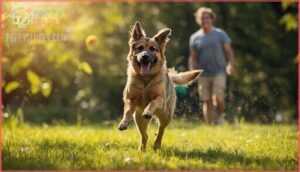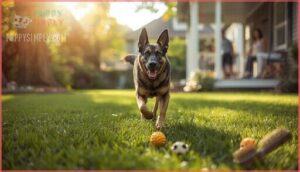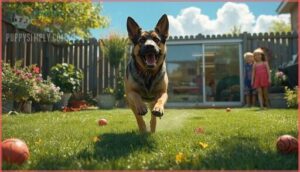This site is supported by our readers. We may earn a commission, at no cost to you, if you purchase through links.

These dogs can be absolute sweethearts with proper training, or they can develop the stranger reactivity that affects 40% of poorly socialized individuals.
Whether you’re considering adding one to your family or just trying to understand the breed better, knowing what drives their behavior—and what health issues lurk in their genetics—makes all the difference between a loyal companion and a handful you weren’t prepared for.
Table Of Contents
- Key Takeaways
- German Shepherd Lab Mix Overview
- German Shepherd Lab Mix Personality
- Training a German Shepherd Lab Cross
- Exercising Your German Sheprador
- Grooming Needs of a German Shepherd Lab
- German Shepherd Lab Health Concerns
- Finding a German Shepherd Lab Mix
- Bringing Home Your German Shepherd Lab Puppy
- Living With a German Shepherd Lab
- Is a German Shepherd Lab Right for You?
- Frequently Asked Questions (FAQs)
- What are the traits of a German Shepherd Lab mix?
- How much does a German Shepherd Lab Mix cost?
- Is the German Shepherd Lab Mix a good watchdog?
- What climate conditions do German Shepherd Labs prefer?
- What is the typical lifespan of a Sheprador?
- Are Shepradors good with children and other pets?
- What size crate does a Sheprador need?
- Do German Shepherd Lab Mixes bark a lot?
- Conclusion
Key Takeaways
- Shepradors demand 60-90 minutes of daily high-intensity exercise and consistent training from puppyhood—without this structure, you’re looking at a 40% chance of stranger reactivity and destructive behaviors that stem from boredom and poor socialization.
- These dogs inherit serious health vulnerabilities from both parent breeds, including hip dysplasia (affecting 20-31% depending on lineage), degenerative myelopathy in 17% of German Shepherd genetics, and a genetic obesity mutation in up to 25% of Lab lines that requires vigilant weight management.
- The financial reality extends beyond the $650-$2,500 purchase price—expect around $1,800 yearly just for veterinary care, plus grooming tools, quality high-protein food, and potential joint supplements to manage inherited conditions.
- Early socialization before 16 weeks is non-negotiable: exposing puppies to 30+ different people, sounds, and places during this critical window reduces adult reactivity by 60% and cuts fear behaviors by 70%, making the difference between a well-adjusted companion and a reactive handful.
German Shepherd Lab Mix Overview
The German Shepherd Lab mix—also called a Sheprador—brings together two of America’s most beloved breeds into one powerhouse package. You’ll find this crossbreed carries traits from both parents, creating a dog that’s equal parts loyal guardian and enthusiastic companion.
Let’s break down what you can expect regarding looks and personality.
Appearance
Your German Shepherd Lab mix stands between 20 and 27 inches tall, generally weighing 50 to 100 pounds with a muscular, athletic body structure built for endurance. Their double coat ranges from short to medium-length, coming in colors like black, tan, chocolate, yellow, or mixed patterns that blend German Shepherd saddle markings with Labrador solid tones.
Facial features include a long, tapered muzzle, brown almond-shaped eyes, and a dark nose—about half sport that distinctive black German Shepherd mask. Ear types vary: some pups get upright Shepherd ears while others inherit floppy Lab ones.
Shedding patterns intensify twice yearly when that dense undercoat releases, so coat care means regular brushing to manage the fur. To maintain their overall health, owners should be aware of common health issues.
Temperament
That wagging tail and eager-to-please attitude don’t tell the whole story—understanding German Shepherd Lab Mix characteristics means looking at their emotional stability and behavioral patterns. While 82% of Shepradors are friendly with children, your dog’s temperament and behavior depend heavily on early socialization.
Here’s what shapes their canine behavior:
- Social skills develop early: Poor socialization before six months increases stranger reactivity by 40%
- Anxiety triggers are real: Over 40% show stress behaviors when left alone beyond six hours
- Fear factors vary widely: About 12% display shyness, while 6% experience occasional anxiety in new settings
Most Shepradors balance protectiveness with playfulness, but consistent dog behavior and training prevent dominance issues affecting roughly 20% of untrained pups. Regular veterinary check-ups are essential for maintaining the health conscious needs of your pet.
German Shepherd Lab Mix Personality
Your Sheprador’s personality reflects strong emotional intelligence that shows up in everyday life. These dogs read your moods like a book, responding to stress with gentle nudges or matching your excitement with tail-wagging enthusiasm. They’re natural people-pleasers who form intense social bonds—about 91% stick close to their favorite humans like velcro. You’ll notice loyalty traits that make them alert to strangers while staying warm with family.
Here’s the catch: their attachment styles run deep. Nearly half struggle when left alone too long, and that devotion can flip into separation anxiety without proper management. But with early socialization and consistent routines, you’ll channel those behavioral quirks into something beautiful—a companion who’s protective without aggression, playful without chaos, and sensitive to the emotional temperature of your home.
Their deep attachment can flip into separation anxiety without proper management, but early socialization channels that devotion into balanced companionship
Training a German Shepherd Lab Cross
You’ve got a smart, keen dog who craves structure—and that makes training your German Shepherd Lab mix surprisingly rewarding. Start with positive reinforcement using treats and praise, which boosts command retention by about 70% compared to harsh corrections. Those early weeks matter: puppies under 12 weeks soak up new experiences like sponges, so introduce them to at least 30 different people, sounds, and places before they hit 16 weeks.
Here’s your training roadmap:
- Master basic obedience commands like sit, stay, and come during short 10–15 minute sessions to keep their attention sharp
- Use crate training early (around eight weeks) to build independence and cut separation anxiety by half
- Practice socialization techniques through controlled meetups with other dogs, reducing adult reactivity by 60%
- Teach impulse control with “leave it” and “wait” commands, especially important for their high prey drive
- Add agility exercises or nose work to satisfy their working-dog heritage and improve cooperation by 25%
Consistency across everyone in your household makes all the difference—it nearly doubles obedience retention.
Exercising Your German Sheprador
Your German Shepherd Lab Mix needs 60–90 minutes of high-intensity physical exercise daily to stay balanced and prevent destructive habits. Split this into two sessions—morning and evening walks lasting 30–45 minutes each work well for busy households. Mix up your exercise types: swimming twice weekly protects joints while building muscle, hiking 3–5 miles strengthens cardiovascular health, and fetch sessions burn serious calories while satisfying their retrieving instincts.
Don’t just tire their legs—challenge their brains. Weave obedience commands into playtime to cut anxiety by 40%, or try scent games that tap into their natural tracking abilities. Alternate your walking routes weekly to keep mental stimulation high. These Daily Routines addressing both energy levels and mental needs reduce boredom-related behavior by 30%. The Health Benefits stack up fast: consistent activity lowers hip dysplasia risk by 25% and can add over a year to your dog’s life.
Grooming Needs of a German Shepherd Lab
That dense double coat isn’t just beautiful—it’s a full-time commitment. Your German Shepherd Lab Mix grooming routine centers on shedding control, since these dogs shed year-round with intense peaks during spring and fall coat blows. Brushing techniques matter: use a slicker brush for surface debris and an undercoat rake to pull dead fur from deep within the double layers. Aim for 3–4 sessions weekly, bumping up to daily during heavy shedding cycles.
Coat maintenance extends beyond brushing alone:
- Bathe every 2–3 months with double-coat shampoo to preserve natural oils—overbathing strips protection and triggers more shedding.
- Trim nails every 3–4 weeks to prevent joint strain and maintain proper footing during exercise.
- Clean ears weekly and brush teeth regularly to support overall skin health and prevent infections.
Quality tools like the Furminator can cut loose fur by 90% during peak seasons, making dog grooming sessions far more effective for serious coat care.
German Shepherd Lab Health Concerns
Like their purebred parents, Shepradors can inherit certain health vulnerabilities that you’ll want to keep on your radar. Understanding what each breed brings to the table helps you spot potential issues early and keep your dog thriving.
Let’s break down the health concerns from both the Labrador and German Shepherd sides.
Labrador Health Issues
Your Labrador Retriever’s genetic heritage brings a mixed bag in terms of dog health issues. Hip Dysplasia affects roughly 31% of Labs, though breeding improvements have lowered rates notably over the past few decades. Elbow Dysplasia is another joint problem you’ll want to watch for—both conditions can lead to painful Arthritis Care needs down the road.
Eye Problems, particularly progressive retinal atrophy, can steal your dog’s vision gradually, making Genetic Testing of parent dogs absolutely essential before you commit.
Here’s the kicker: Obesity Risks are sky-high in Labs due to a genetic mutation affecting up to 25% of the breed, which cranks up appetite and body fat storage. Regular vet visits, joint supplements, and keeping those treat bowls in check will help your Sheprador dodge these common Labrador health landmines.
German Shepherd Health Issues
German Shepherds carry a heavier genetic burden than Labs regarding serious dog health issues. Hip dysplasia affects roughly 20% of the breed, while elbow dysplasia and other elbow issues cause joint pain that worsens with age. But here’s what really sets them apart:
- Degenerative Myelopathy affects about 17% of German Shepherds, causing hind-leg paralysis with no cure—only physical therapy to slow progression.
- Pancreatic Disorders like exocrine pancreatic insufficiency strike around 1%, requiring lifelong enzyme supplements to prevent malnutrition.
- Cardiac Problems and Bloat are serious threats, with bloat being a life-threatening emergency where the stomach twists.
Your Sheprador inherits these risks, so ask breeders about genetic screening and parent health clearances before bringing a puppy home.
Finding a German Shepherd Lab Mix
So you’ve decided a Sheprador might be the right fit for your home—now comes the fun part of actually finding one. You’ve got two main routes to explore: working with a breeder or checking out rescue organizations. Let’s walk through what each option looks like and what you should keep in mind.
Breeders
Finding a trustworthy Sheprador breeder takes some detective work, but it’s worth the effort. Start by asking to see health screening results for both the German Shepherd and Labrador Retriever parents—reputable breeders test for hip dysplasia, elbow dysplasia, and eye conditions.
Expect to pay between $650 and $2,500 depending on the breeder’s health testing and location. Visit their facility if possible; around 70% of quality breeders welcome tours. Look for clean kennels, well-socialized puppies, and a breeder who asks you questions too—good ones screen buyers carefully.
They’ll provide a health guarantee, puppy records, and ongoing support after you bring your German Shepherd Lab mix home.
Rescues
You won’t find Sheprador puppies sitting pretty at most breeders—but shelters? That’s where these canine companions often wait for their second chance. Mixed-breed dogs like the German Shepherd Lab Mix made up over 54% of shelter intakes in 2024, and adoption trends show these dogs often land in shelter life due to owner unpreparedness rather than behavioral flaws.
Here’s your rescue game plan:
- Search breed-specific groups like Shenandoah Shepherd Rescue or Virginia German Shepherd Rescue—they rehome 300+ Shepherds and mixes annually and understand rehoming challenges unique to high-energy breeds.
- Connect with foster care networks through Petfinder or local shelters, where you can learn about a rescue dog’s real personality and dog health history.
- Ask detailed questions about exercise needs, separation anxiety, and previous dog ownership experiences—rescue efforts work best when expectations match reality.
Adoption fees usually run $150–$400, including vet care and vaccinations.
Bringing Home Your German Shepherd Lab Puppy
Once you’ve found your Sheprador, the real work begins—and trust me, those first few days set the tone for everything. Start with puppy proofing: cover electrical cords, stash toxic chemicals, and remove choking hazards since 18% of early vet visits stem from ingestion accidents. Your pup will hit 10–20 pounds by 8 weeks, so secure baby gates and fencing now.
Set up separate zones for feeding, sleeping, and potty breaks to build routine fast. Schedule that first veterinary care visit within 72 hours to confirm vaccinations and start deworming—it cuts intestinal worms by 80%. For nutrition setup, choose high-protein puppy food (22–24% protein) split into three meals daily to prevent bloat.
Socialization tips? Expose your German Shepherd Lab mix to 5–7 new stimuli weekly during weeks 8–16—this critical window slashes fear behaviors by 70% later on.
Living With a German Shepherd Lab
Day-to-day life with your German Shepherd Lab mix means weaving exercise, training, and companionship into every routine. These high-energy dogs thrive on 90 minutes of vigorous activity daily—think trail runs, fetch sessions, or agility drills—to keep restlessness at bay. Family dynamics improve when you establish clear household rules early and practice obedience cues 5–10 times daily to manage their protective instincts. Space requirements matter too: they need several hundred square feet to stretch out comfortably, plus access to enclosed outdoor areas that cut anxiety-driven barking by 40%.
Your daily routine should include:
- Mental workouts alongside physical ones: puzzle toys and scent games double attention spans in intelligent breeds like this
- Consistent grooming sessions: brush 3–4 times weekly to tackle heavy shedding and maintain skin health
- Structured socialization tips: expose them to parks, crowds, and varied environments regularly—continuous exposure produces calmer temperaments than home-only living
Household adaptation happens smoothly when you pair exercise with training. Over 80% of Shepradors adjust well to suburban and urban settings if socialized before six months. As a family pet, this German Shepherd Lab mix rewards your commitment with unwavering loyalty, though dog ownership experiences vary—some days feel taxing, others pure joy. Dog socialization never stops; even adult dogs benefit from new experiences that reinforce confidence and good manners.
Is a German Shepherd Lab Right for You?
You’ve seen how daily life with a German Shepherd Lab mix demands structure and energy—but does your world actually fit their needs? Let’s talk Lifestyle Assessment. If you can’t carve out 90 minutes daily for vigorous runs or training drills, this crossbreed will struggle. Family Dynamics matter too: 84% of owners say they’re great with kids when socialized properly, yet their protective streak and high energy levels can overwhelm quieter households.
Cost Considerations add up fast—expect around $1,800 yearly for veterinary care alone. Time Commitment extends beyond exercise: these dogs need mental challenges, consistent dog socialization, and obedience work for at least two years. Your Living Situation plays a deciding role: apartment dwellers face triple the challenges compared to homes with fenced yards.
Ask yourself:
- Can you provide twice-daily exercise without fail?
- Do you have outdoor space and an active routine?
- Are you ready for a demanding but deeply loyal family pet?
If you’ve answered yes with confidence, a German Shepherd Lab mix will reward your dedication with unshakable loyalty. If doubts linger, consider whether your dog ownership experiences align with this breed’s intensity.
Frequently Asked Questions (FAQs)
What are the traits of a German Shepherd Lab mix?
This hybrid breed brings together intelligence levels and energy requirements that can surprise first-time owners.
Shepradors usually weigh 50-88 pounds with dense coats in various colors, showcasing common personality traits like loyalty and protectiveness combined with outstanding trainability.
How much does a German Shepherd Lab Mix cost?
You’ll find purchase costs ranging from $200 to $4,500, depending on whether you choose adoption or a breeder.
Adoption fees usually run $125 to $350, while reputable breeders charge $2,000 to $4,500 for quality puppies with health clearances.
Is the German Shepherd Lab Mix a good watchdog?
Shepradors can make solid watchdogs—they’re naturally alert and often inherit protective instincts from their German Shepherd parent.
You’ll likely get vocal warnings when strangers approach, plus their size alone acts as a deterrent.
Just remember, training and socialization shape how effectively they guard.
What climate conditions do German Shepherd Labs prefer?
What temperature range suits your Sheprador best? German Shepherd Lab mixes prefer cooler conditions, thriving between 50°F and 85°F. Their double coat increases heat retention in hot weather, so monitor exercise intensity and provide shade.
In cold conditions, their insulation helps, though humidity levels above 60% impair their cooling efficiency through panting.
What is the typical lifespan of a Sheprador?
Most Sheprador dogs live around 10 to 14 years, with genetics and healthcare playing key roles in longevity.
Hip dysplasia, bloat, and cancer are common health risks that can affect their aging process and overall lifespan.
Are Shepradors good with children and other pets?
When properly socialized early, these dogs usually shine as family pets—patient with kids and friendly toward other animals.
Their loyalty and eagerness to please make them great companions, though you’ll need consistent training and supervision to manage their protective instincts and prey drive around small pets.
What size crate does a Sheprador need?
Think of a crate like a custom-fitted suit—it should fit just right. Your Sheprador needs a 42-inch crate minimum, allowing space to stand, turn around, and stretch comfortably without feeling cramped or having excess room that encourages accidents.
Do German Shepherd Lab Mixes bark a lot?
Yes, they’re quite vocal dogs. Barking triggers include strangers, environmental stimuli, boredom, and anxiety.
Training methods focusing on positive reinforcement help with bark reduction and noise management, especially when combined with adequate exercise and mental stimulation.
Conclusion
They need consistency—your German Shepherd Lab mix thrives on it. They need movement—without daily exercise, destructive behaviors emerge. They need guidance—early socialization prevents the reactivity that plagues undertrained dogs.
This crossbreed rewards your investment with unshakeable loyalty and adaptable companionship, but only if you’re prepared for the work. If you’ve got the time, space, and commitment to meet their physical and mental demands, you’re looking at 10-14 years with one of the most devoted dogs you’ll ever own.
- https://articles.hepper.com/german-sheprador/
- https://www.allthingsdogs.com/german-shepherd-lab-mix/
- https://www.facebook.com/groups/1604086962989282/posts/8559323934132182/
- https://wamiz.co.uk/dog/advice/1081/the-german-shepherd-cross-labrador
- https://www.petscare.com/news/post/german-shepherd-lab-mix-guide

















